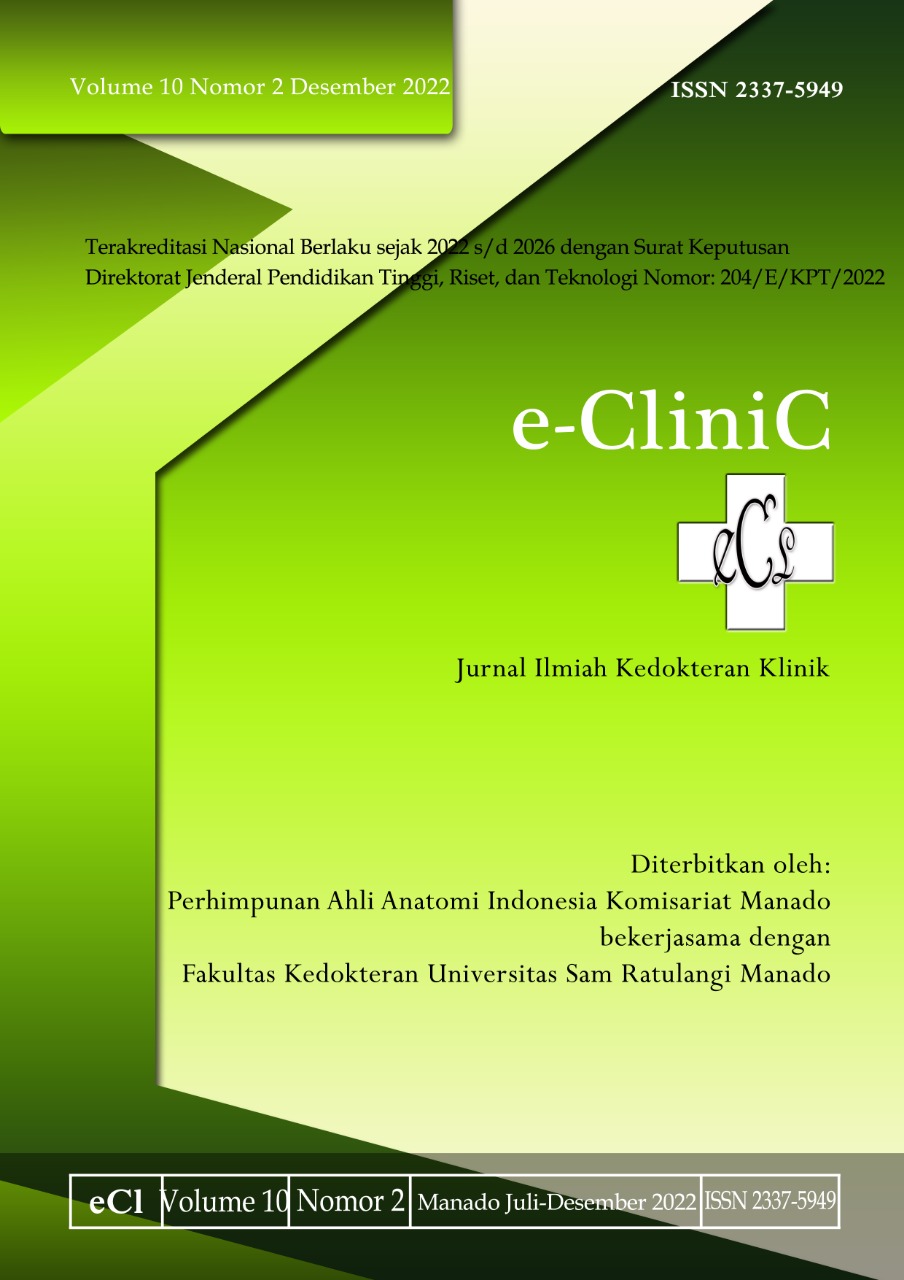Profile of Pregnant Women with Previous Cesarean Section during Covid-19 Pandemic
DOI:
https://doi.org/10.35790/ecl.v10i2.38124Abstract
Abstract: Pregnancy with previous cesarean section (CS) is risky due to the presence of stiff uterine scar tissue which may rupture during pregnancy or delivery. However, the restrictions on health services during the Covid-19 pandemic coupled with the unequal distribution of vaccinations for pregnant women become a great concern and challenge. This study aimed to obtain the profile of pregnant women with previous SC during Covid-19 pandemic. This was a descriptive and observa-tional survey study with a cross sectional design. Samples were all pregnant women with previous SC who came for antenatal care at Puskesmas Makale and RSUD Lakipadada Tana Toraja from October to December 2021. The results showed that of 48 pregnant women with previous SC the highest percentages were, as follows: ages of 25-35 years (81.3%); had one previous SC (81.3%); had planned the pregnancy (72.9%); admitted that had known the risk of pregnancy (79.2%); had more frequent antenatal care (43.8%); had known the estimated delivery (89.6%); and preferred VBAC (52.1%) at a health facility (93.8%). In conclusion, most of the pregnant women admitted that they had planned their pregnancies and known the risks of pregnancy with previous SC during the Covid-19 pandemic, therefore, they had more frequent antenatal care. They also knew their esti-mated delivery and tended to choose a VBAC at a health facility.
Keywords: risky pregnancy; previous cesarean section; Covid-19 pandemic
 Â
Abstrak: Kehamilan dengan bekas seksio sesarea (SC) merupakan salah satu kehamilan berisiko, dikaitkan dengan adanya jaringan kaku parut uterus yang mungkin dapat ruptur selama kehamilan atau persalinan. Dalam masa pandemi pembatasan yang dilakukan di layanan kesehatan ditambah belum meratanya vaksinasi bagi ibu hamil menjadi kekhawatiran dan tantangan tersendiri. Penelitian ini bertujuan untuk mengetahui profil ibu hamil dengan bekas SC, pada masa pandemi Covid-19. Jenis penelitian ialah observasional deskriptif survei dengan desain potong lintang. Sampel penelitian ialah ibu hamil dengan bekas SC yang datang untuk pemeriksaan antenatal di Puskesmas Kecamatan Makale dan RSUD Lakipadada Tana Toraja pada bulan Oktober-Desember 2021. Hasil penelitian mendapatkan 48 ibu hamil bekas SC dengan distribusi terbanyak yaitu usia 25-35 tahun (81,3%); riwayat SC satu kali (81,3%); telah merencanakan kehamilannya (72,9%); mengaku sudah mengetahui risiko kehamilan dengan bekas SC (79,2%); lebih sering melakukan pemeriksaan antenatal (43,8%); dan telah mengetahui taksiran persalinannya (89,6%) dengan preferensi metode persalinan VBAC (52,1%) di fasilitas kesehatan (93,8%). Simpulan penelitian ini sebagian besar ibu memang telah merencanakan kehamilannya dan mengaku sudah mengetahui risiko kehamilan dengan bekas SC pada masa pandemi Covid-19, sehingga mayoritas melakukan pemeriksaan antenatal lebih sering. Mayoritas ibu hamil telah mengetahui taksiran persalinannya dan jika dapat memilih mereka cenderung memilih metode persalinan VBAC di fasilitas kesehatan.
Kata kunci: kehamilan berisiko; bekas seksio sesarea; pandemi Covid-19Downloads
Additional Files
Published
How to Cite
Issue
Section
License
COPYRIGHT
Authors who publish with this journal agree to the following terms:
Authors hold their copyright and grant this journal the privilege of first publication, with the work simultaneously licensed under a Creative Commons Attribution License that permits others to impart the work with an acknowledgment of the work's origin and initial publication by this journal.
Authors can enter into separate or additional contractual arrangements for the non-exclusive distribution of the journal's published version of the work (for example, post it to an institutional repository or publish it in a book), with an acknowledgment of its underlying publication in this journal.
Authors are permitted and encouraged to post their work online (for example, in institutional repositories or on their website) as it can lead to productive exchanges, as well as earlier and greater citation of the published work (See The Effect of Open Access).







